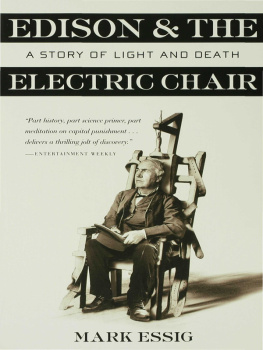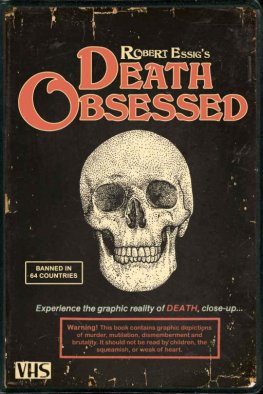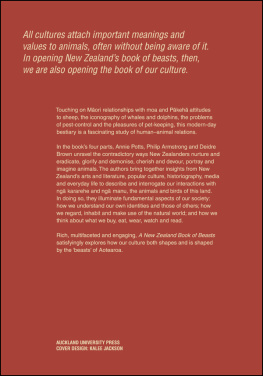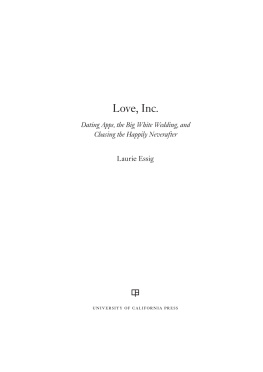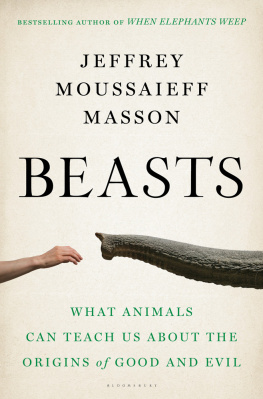More Advance Praise for
Lesser Beasts
Mark Essig tells a fine tale of the unsung exploits of the lowly pig, from the age of the pyramids and the wars of the conquistadors to the awful abattoirs and trendy restaurants of today. With clear prose and careful research, he redeems an animal that has played a seminal role in human history while enduring near universal disdain. This fascinating book provides a marvelous antidote to our unexamined views on the pig. Andrew Lawler, author of Why Did the Chicken Cross the World? The Epic Saga of the Bird That Powers Civilization
Lesser Beasts is a delightful romp through porcine history from the Neolithic era to the present. Mark Essig offers surprising answers to the question of why humans have had such a love-hate affair with the humble pig, and unveils many other unexpected insights. Well written and well researched, Lesser Beasts is a must for historians, pork lovers, and anyone who just loves a good read. Andrew F. Smith, editor-in-chief, The Oxford Encyclopedia of Food and Drink in America
Lesser Beasts
Lesser
Beasts
A Snout-to-Tail History of the Humble Pig
Mark Essig

A Member of the Perseus Books Group
New York
Copyright 2015 by Mark Essig
Published by Basic Books,A Member of the Perseus Books Group
All rights reserved. Printed in the United States of America. No part of this book may be reproduced in any manner whatsoever without written permission except in the case of brief quotations embodied in critical articles and reviews. For information, address Basic Books, 250 West 57th Street, 15th floor, New York, NY 10107.
Books published by Basic Books are available at special discounts for bulk purchases in the United States by corporations, institutions, and other organizations. For more information, please contact the Special Markets Department at the Perseus Books Group, 2300 Chestnut Street, Suite 200, Philadelphia, PA 19103, or call (800) 810-4145, ext. 5000, or e-mail .
Designed by Pauline Brown
Library of Congress Cataloging-in-Publication Data
Essig, Mark, 1969
Lesser beasts : a snout-to-tail history of the humble pig / Mark Essig.
pages cm
Includes index.
ISBN 978-0-465-04068-1 (e-book) 1. SwineHistory. 2. Pork History. I. Title.
SF395.E64 2015
636.4dc23
2014049256
10 9 8 7 6 5 4 3 2 1
For Melissa, Jack, and Lydia
Cattle country calls up instant visions of distant mountains and wind-swept plains leading off to nowhere and cattle grazing on slopes and tattooed men in wide-brim hats gathered around a fire with their horses standing stalwartly in the background.... But who, among the teeming city masses, knows about hog country? Who knows where lies that land?
William Hedgepeth, The Hog Book
Humble? said Charlotte. Humble has two meanings. It means not proud and it means near the ground. Thats Wilbur all over. Hes not proud and hes near the ground.
E. B. White, Charlottes Web
Contents
O n a trip through the North Carolina mountains in 1878, Virginia newspaper editor James Cowardin found himself surrounded by thousands of pigs. Hogs were before us and behind us, and both to the right and to the left of us, Cowardin wrote. There was whipping and shouting and twisting and turning as the swineherds yelled, Suey! Suey! Get out! Suey hogs! Dd devil take the swine! Cowardin too cursed the pigs at first, but once he settled into the rhythm of the road, he began to daydream about following his grunting friends to their destination and enjoying a pig slaughter feast: What luxury in spare ribs, backbone, and sausage we would have, he fantasized, not to mention pigs tails broiled on hot rocks!
The flesh of Cowardins traveling companions, though, was destined for other stomachs. He had stumbled upon a seasonal movement of livestock that had been happening each winter for half a century. The swine had been fattened in eastern Tennessee, a fertile farming region with many pigs and few people. A couple of hundred miles away lay the plantations of the South, which didnt raise much food. Planters preferred to grow cotton, sell it for cash, and buy pork to feed their slaves (or, after the Civil War, their sharecroppers and tenant farmers). The hog supply was in Tennessee, the demand in South Carolina and Georgia, and in between lay the Blue Ridge mountains. No rivers or railroads connected the two, so there was only one way to move the hogs: on foot.
Hog droving, as the practice was known, formed an essential link in the global economy. In peak years as many as 150,000 hogs made the journey on this single turnpike, and many other mountain routes also carried pigs from upland farms to the Deep South. The pork fed the slaves, who raised the cotton, which supplied textile mills in New England and Great Britain, which made the fabric that clothed the world. And it all depended on a few men herding hogs through a narrow river valley cutting through the mountains of North Carolina.
I first learned of hog drives in 2007, not long after my family and I settled in those mountains. A historical marker revealed that livestock drovers once traversed a road near our home in Asheville, North Carolina. I had thought cattle drives happened on the Great Plains, not in the mountains, so I headed to the library, where I read books on local history, scanned microfilm of nineteenth-century newspapers, and searched Google Books for old runs of defunct farming magazines. And I discovered the strange truth: most of the animals herded through Asheville had been not cows or even sheep but pigs.
The story of these pigs, I learned, was even etched into the landscape: a local farmer showed me a spot on his land where an old drovers road is still visible, a deep trench cut into the clay soil by decades of wagon wheels and sharp little hooves. Think of it: pig drives! Like cattle drives, only stranger! Who knew a pig could walk that far or would travel in the desired direction? Apparently not many people: I read a 2006 article by a prominent archaeologist, a specialist in livestock, who baldly insisted that pigs cannot be driven. The historical record suggests that pigs can indeed be driven. In fact, if you gave them a few lessons and a specially designed steering wheel, I wouldnt be surprised if pigs could drive.
At about this time I started teaching journalism at Warren Wilson College, a liberal arts school that also operates a farm. The animals live on pasture, and nutrients cycle from the soil into crops, from crops into the mouths of animals, and from animal manure back into the soil. I observed this cycle firsthand one day each week when I volunteered on the pig crew. Working alongside students, I scraped manure, topped up feeders, clipped the milk teeth of newborn piglets, and castrated the young males. I spent a lot of time just watching: a dominant sow chasing off her weaker sisters to get first dibs at the trough; enormous boars, rendered bowlegged by their cantaloupe-sized testicles, hoisting themselves atop sows in heat; young pigs scattering across the pasture as I approached, then returning to sniff and prod at my boots with their snouts. A boar known as Guccithe students made the most of their naming dutieswould prop his front legs on the wall of his pen and gaze around the farmyard contentedly, a lord surveying his estate. The pigs were by turns curious, surly, skittish, and playful. They were the most fascinating creatures in the barnyard, brainy and fully alive.
Next page

